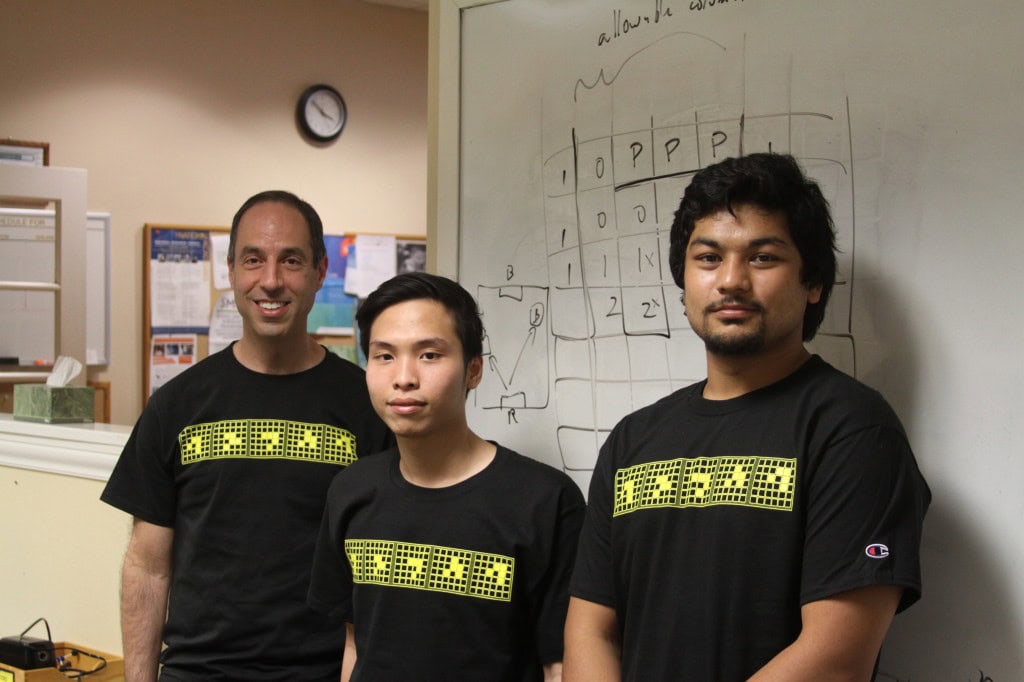The Game of Life takes on a new dimension in Summer Research
Ever since its invention in the 1960s, Conway’s Game of Life has provided a puzzle for mathematics students. But it lacked some essential elements of a game: it is not interactive, and there is no competition.
This summer, two Randolph students and a professor worked together to remedy that issue as part of their Summer Research project
 The Game of Life, developed by mathematician John Conway, begins with a pattern on a grid with some cells being turned on and others off. With each repeated generation of the game, any cell with at two or three living neighbors will turn on or stay alive. But any cell that has more or fewer active neighbors will die, as if from overcrowding or underpopulation.
The Game of Life, developed by mathematician John Conway, begins with a pattern on a grid with some cells being turned on and others off. With each repeated generation of the game, any cell with at two or three living neighbors will turn on or stay alive. But any cell that has more or fewer active neighbors will die, as if from overcrowding or underpopulation.
“What we’ve been doing this summer is taking this model and turning into a competitive game between two teams,” said Marc Ordower, a Randolph mathematics professor. “It seems like really fertile territory. I think that there will be general interest.”
Pujan Shrestha ’15 and Tu Nguyen ’15 worked with Ordower this summer. They designed a game in which there are two teams. Each team creates patterns that then propagate according to the normal rules of game of life. The goal is to create a pattern that moves across the grid and invades the other team’s section of the board.
In addition to writing a game program, the researchers worked on discovering patterns that cause certain actions in the game. “We’re trying to understand patterns that do what we want them to do,” Shrestha said.
There are millions of potential combinations to explore, which means that there is a lot to comprehend about the game. “One of the problems we have is that during the game, we can’t tell whether one team is winning or not, so we’re trying to make it more controllable and less random,” Nguyen said.
 |
 |
|
Two patterns that demonstrate the way cells propagate in Conway’s Game of Life.
|
|
“It’s like an untrained chess player looking at a board between two masters and not being able to see who is in the lead,” Ordower said. “Just because we know the rules, doesn’t mean we know the strategy. We’re trying to tweak the rules so that the game looks less random to us.”
One of the changes would involve designating certain parts of the grid that players must avoid, requiring them to be more strategic about the patterns they use.
As they continue to learn more about the strategies that can be used in the game, they plan to give it a new dimension. They have worked with Chris Cohen, a programmer in the College’s information technology office, to create a three-dimensional game. But even once they get the 3-D version running, they need to start all over with understanding the strategy players can use in the game.
A short video of the latest 3D version.
The third dimension introduces many more potential patterns, which will challenge the group to start from square one to develop strategic patterns. Ordower said this will challenge their mathematical thinking because it will force the students to go beyond classical mathematical methods of solving a problem and focus instead on discovering something new.
“These two are the world’s experts on this topic,” Ordower said. “Up till now, when they’ve had a question they’ve been able to go ask somebody. But now there’s no one to ask. If they want it done now, they have to do it themselves.”
Tags: mathematics, research, student faculty research, summer research, summer research 2014
